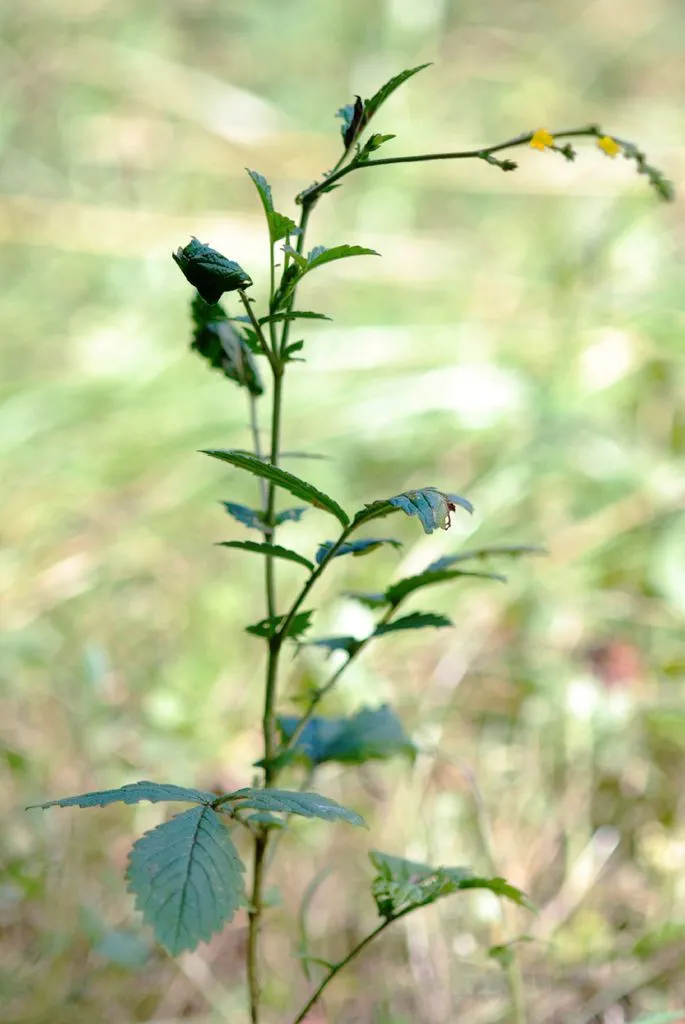
Author: Wallr.
Bibliography: Beitr. Bot. 1: 45 (1842)
Year: 1842
Status: accepted
Rank: species
Genus: Agrimonia
Vegetable: Unknown
Observations: SE. Canada to C. & E. U.S.A.
Downy Agrimony, known scientifically as Agrimonia pubescens, is a distinguished member of the Rosaceae family. First documented in 1842 by Wallroth in “Beitr. Bot. 1: 45,” this perennial herb is native to the regions extending from Southeastern Canada to the central and eastern United States.
Characterized by its graceful, down-covered stems and delicately toothed leaves, Downy Agrimony adds a subtle charm to forest edges, meadows, and open woodlands. This plant thrives in well-drained, slightly acidic to neutral soils and prefers locations where it can receive partial to full sunlight. The downy texture of Agrimonia pubescens is a key identifying feature, giving the plant a soft and velvety appearance which is particularly noticeable on the leaf undersides and stems.
During its blooming period, Agrimonia pubescens produces slender spikes adorned with small, bright yellow flowers. Each flower typically comprises five petals, forming a striking contrast against the plant’s greenery. These flowers eventually give way to bristly seed pods that cling to animal fur or clothing, aiding in the plant’s propagation.
Ecologically, Downy Agrimony plays an essential role in its habitat. It attracts a variety of pollinators, including bees and butterflies, which are crucial for maintaining the health and diversity of the ecosystem. Additionally, its dense foliage provides shelter and food for various insects and small wildlife.
Cultivation of Downy Agrimony in home gardens can be a rewarding experience for those aiming to create a more naturalistic landscape that supports local wildlife. Its minimal maintenance requirements and adaptability make it an ideal choice for wildflower gardens or naturalistic planting schemes.
In conclusion, Agrimonia pubescens, or Downy Agrimony, is a plant of considerable ecological value and understated beauty. Its presence enhances the biodiversity and visual appeal of natural landscapes across its native range in North America.
Eng: downy agrimony, groovebur, hairy agrimony, roadside agrimony, soft agrimony, soft groovebur, soft grooveburr
Fra: aigremoine pubescente
En: Downy agrimony, Hairy agrimony, Soft agrimony, GROOVEBUR, Roadside agrimony, Soft groovebur, Soft grooveburr
Fr: Aigremoine pubescente
Taken Jul 18, 2010 by EOL − Ron Thomas (cc-by-nc-sa)
Taken Jul 18, 2010 by EOL − Ron Thomas (cc-by-nc-sa)
Taken Jul 18, 2010 by EOL − Ron Thomas (cc-by-nc-sa)
Taken Jul 18, 2010 by EOL − Ron Thomas (cc-by-nc-sa)
Taken Sep 17, 2022 by Michał Maciążek (cc-by-sa)
Taken Jun 19, 2019 by Matt (cc-by-sa)
Taken Aug 14, 2004 by EOL − Steven J. Baskauf (cc-by-nc-sa)
Taken Jul 18, 2010 by EOL − Ron Thomas (cc-by-nc-sa)
Taken Jan 1, 1900 by EOL − John Hilty (cc-by-nc)
Taken Jul 18, 2010 by EOL − Ron Thomas (cc-by-nc-sa)
Taken Oct 19, 2018 by Sonya Charest (cc-by-sa)
Taken Aug 14, 2004 by EOL − Steven J. Baskauf (cc-by-nc-sa)
Taken Jul 18, 2010 by EOL − Ron Thomas (cc-by-nc-sa)
Taken Aug 14, 2004 by EOL − Steven J. Baskauf (cc-by-nc-sa)
Taken Jan 1, 1900 by EOL − WVU Herbarium (cc-by-nc-sa)
Family: Myrtaceae Author: (F.Muell.) K.D.Hill & L.A.S.Johnson Bibliography: Telopea 6: 402 (1995) Year: 1995 Status:…
Family: Rubiaceae Author: Pierre ex A.Froehner Bibliography: Notizbl. Bot. Gart. Berlin-Dahlem 1: 237 (1897) Year:…
Family: Sapindaceae Author: Koidz. Bibliography: J. Coll. Sci. Imp. Univ. Tokyo 32(1): 38 (1911) Year:…
Family: Asteraceae Author: A.Gray Bibliography: Pacif. Railr. Rep.: 107 (1857) Year: 1857 Status: accepted Rank:…
Family: Fabaceae Author: Medik. Bibliography: Vorles. Churpfälz. Phys.-Ökon. Ges. 2: 398 (1787) Year: 1787 Status:…
Family: Aspleniaceae Author: (Cav.) Alston Bibliography: Bull. Misc. Inform. Kew 1932: 309 (1932) Year: 1932…